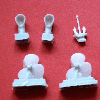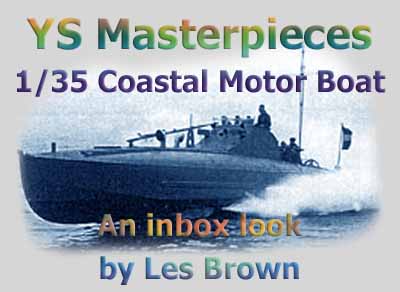| The first thing that struck me when I
received this kit was the hull – approximately 47cm long, with a maximum
beam of 9cm and a depth of 6cm and weighing nearly 1.5kg! This hull
is a masterpiece of resin moulding with no air holes (at least not as far
as I can see) and requiring very little cleaning up – just a small amount
on the bottom, along the keel line. There are some slight bumps on
the forward bottom section of the moulding but these can be easily sanded
down, although this will require some of the planking to be re-scribed.
The step and the hull form have been captured very accurately and a
lot of detail, such as the planking referred to above, has been included
on the main moulding. |
|
|
|
|
| The next thing that caught my eye was the instructions – just 51 small
colour photographs of the sub-assemblies, some having a limited amount
of text on them. There is not a title defining specifically what
size or type of CMB has been modelled. The model scales at ‘55ft’
and is fitted with two torpedoes – these boats were built in three different
lengths (40ft, 55ft and 70ft) with many variations of engines being fitted.
The smaller boats had just a single shaft while the larger ones had two
and the ‘55ft’ versions were fitted with either one or two torpedo troughs. |
click images
to enlarge
 |
|
The main thing that is missing is any overall photograph or diagram of
the craft. The photographs included concentrate on various sub-assemblies
and appear adequate if followed closely and in the correct order, but the
modeller is given no impression of what he is producing. Some of
the photographs, without captions, are a little vague at first sight.
For example, the photograph top left on the second page appears to show
the bottom of the craft but on closer inspection the fittings where the
two shafts enter the hull can be seen in position.
There are no painting instructions but as these craft were generally
painted dark grey overall, this is no real problem. It appears that
anti-fouling was not used on the bottom of these craft as they were removed
from the water when not in use. The propellers would be brass and
the shafts a steel colour, while the ship’s wheel would be a dark wood.
The torpedoes, depth charges and guns can be painted in steel or gunmetal
to provide a little variation. |
|
|
| The other major components are the bridge screen and the
two torpedoes with the many smaller components being contained in four
plastic bags – unfortunately there is no component list so that the modeller
can confirm all is present (Y S Masterpieces hope to add a parts list soon)
or to assist with identifying the parts. The smaller parts are well
moulded with little flash but many are attached to large ‘sprues’ that
will need some careful removal. Parts such as the side pieces for
the optional cover over the bridge do contain windows but these have a
fine film of resin over them which requires removal. |
 |
 |
| CONCLUSIONS |
|

This kit will produce a fine and unusual model, but it will require
some patience and research to achieve the best result.
It is obviously intended for those with some experience and not
for the beginner. |


